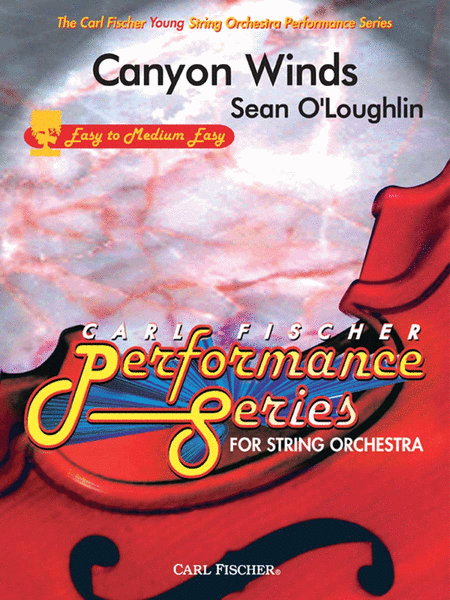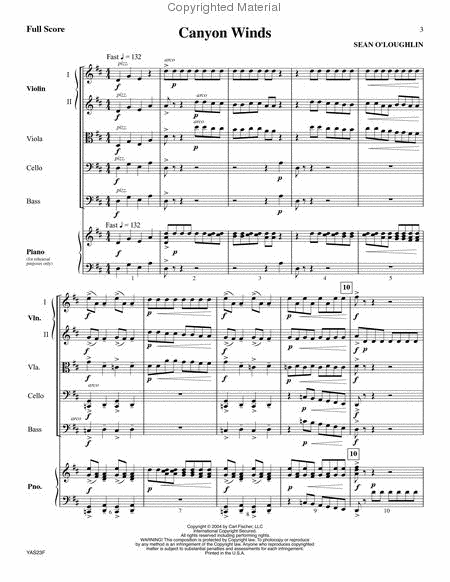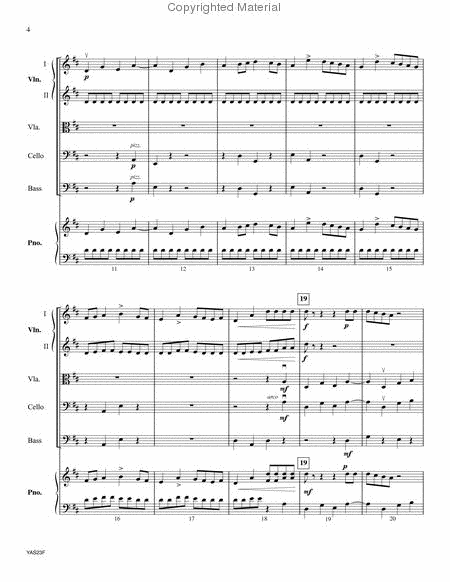Canyon Winds
-
Ships in 1 to 2 weeks
Details
Description
SKU: CF.YAS23
Composed by Sean O'Loughlin. Carl Fischer Young String Orchestra Series. Score and Parts. With Standard notation. 16+16+4+10+10+10+12 pages. Carl Fischer Music #YAS23. Published by Carl Fischer Music (CF.YAS23).ISBN 9780825854934. UPC: 798408054939. 8.5 X 11 inches. Key: D major.
Canyon Winds is an exciting work for string orchestra that harkens back to a time where the American West was a wide-open stretch of land waiting to be explored. Several prominent American composers have put their stamp on the sound of this time period with open-fifth harmonies and vibrant rhythmic intensity. This piece is a product of a cross-country trip I took in June of 2003. There is a section of the Colorado River in Utah that is just gorgeous and is the main inspiration for the music. This stretch of land is several hundred miles north of the Grand Canyon. The music for the whole piece is derived from the opening four-note statement of ascending perfect fourths. The main melody at m. 10 comes right out of this statement. The constant eighth-note gestures provide a driving rhythmic intensity. The viola and cello get a chance at the melody at m. 19. The bass provides counterpoint using only the opening four-note gesture. Violin I contributes addition rhythmic coloring to the section. After some traditional open-fifth fiddle gestures, the melody broadens at m. 37. The ostinato figure in the low strings reminds me of those nature videos I used to watch in junior high and high school. Measure 50 allows the low strings to play the melody with hits in the upper strings. The pizzicato section at m. 65 offers an effective contrast to the driving rhythms so prevalent up to this point. We move right back into the fast section at m. 74 and this leads us to the final large presentation of the melody marked brillante at m. 80. Some recalling of earlier music brings the whole piece to a rousing conclusion.
Canyon Winds is an exciting work for string orchestra that harkens back to a time where the American West was a wide-open stretch of land waiting to be explored. Several prominent American composers have put their stamp on the asounda of this time period with open-fifth harmonies and vibrant rhythmic intensity. This piece is a product of a cross-country trip I took in June of 2003. There is a section of the Colorado River in Utah that is just gorgeous and is the main inspiration for the music. This stretch of land is several hundred miles north of the Grand Canyon. The music for the whole piece is derived from the opening four-note statement of ascending perfect fourths. The main melody at m. 10 comes right out of this statement. The constant eighth-note gestures provide a driving rhythmic intensity. The viola and cello get a chance at the melody at m. 19. The bass provides counterpoint using only the opening four-note gesture. Violin I contributes addition rhythmic coloring to the section. After some traditional open-fifth fiddle gestures, the melody broadens at m. 37. The ostinato figure in the low strings reminds me of those nature videos I used to watch in junior high and high school. Measure 50 allows the low strings to play the melody with hits in the upper strings. The pizzicato section at m. 65 offers an effective contrast to the driving rhythms so prevalent up to this point. We move right back into the fast section at m. 74 and this leads us to the final large presentation of the melody marked brillante at m. 80. Some recalling of earlier music brings the whole piece to a rousing conclusion.
Canyon Winds is an exciting work for string orchestra that harkens back to a time where the American West was a wide-open stretch of land waiting to be explored. Several prominent American composers have put their stamp on the "sound" of this time period with open-fifth harmonies and vibrant rhythmic intensity. This piece is a product of a cross-country trip I took in June of 2003. There is a section of the Colorado River in Utah that is just gorgeous and is the main inspiration for the music. This stretch of land is several hundred miles north of the Grand Canyon. The music for the whole piece is derived from the opening four-note statement of ascending perfect fourths. The main melody at m. 10 comes right out of this statement. The constant eighth-note gestures provide a driving rhythmic intensity. The viola and cello get a chance at the melody at m. 19. The bass provides counterpoint using only the opening four-note gesture. Violin I contributes addition rhythmic coloring to the section. After some traditional open-fifth fiddle gestures, the melody broadens at m. 37. The ostinato figure in the low strings reminds me of those nature videos I used to watch in junior high and high school. Measure 50 allows the low strings to play the melody with hits in the upper strings. The pizzicato section at m. 65 offers an effective contrast to the driving rhythms so prevalent up to this point. We move right back into the fast section at m. 74 and this leads us to the final large presentation of the melody marked brillante at m. 80. Some recalling of earlier music brings the whole piece to a rousing conclusion.
Canyon Winds is an exciting work for string orchestra that harkens back to atime where the American West was a wide-open stretch of land waiting to be explored. Several prominent American composers have put their stamp on the “sound” of this time period with open-fifth harmonies and vibrant rhythmic intensity. This piece is a product of a cross-country trip I took in June of 2003. There is a section of the Colorado River in Utah that is just gorgeous and is the main inspiration for the music. This stretch of land is several hundred miles north of the Grand Canyon.The music for the whole piece is derived from the opening four-note statement of ascending perfect fourths. The main melody at m. 10 comes right out of this statement. The constant eighth-note gestures provide a driving rhythmic intensity. The viola and cello get a chance at the melody at m. 19. The bass provides counterpoint using only the opening four-note gesture. Violin I contributes addition rhythmic coloring to the section. After some traditional open-fifth fiddle gestures, the melody broadens at m. 37. The ostinato figure in the low strings reminds me of those nature videos I used to watch in junior high and high school. Measure 50 allows the low strings to play the melody with hits in the upper strings. The pizzicato section at m. 65 offers an effective contrast to the driving rhythms so prevalent up to this point. We move right back into the fast section at m. 74 and this leads us to the final large presentation of the melody marked brillante at m. 80. Some recalling of earlier music brings the whole piece to a rousing conclusion.
About Carl Fischer Young String Orchestra Series
This series of Grade 2/Grade 2.5 pieces is designed for second and third year ensembles. The pieces in this series are characterized by:
--Occasionally extending to third position
--Keys carefully considered for appropriate difficulty
--Addition of separate 2nd violin and viola parts
--Viola T.C. part included
--Increase in independence of parts over beginning levels



 Share
Share